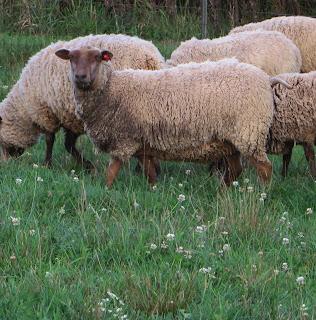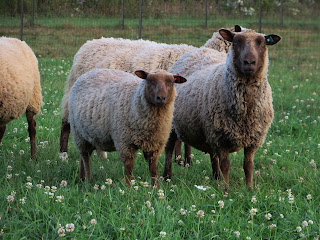I think Shetland Sheep breeders tend to like their flocks
regardless of whether their sheep are good, bad, or average. After visiting 16
flocks, that’s my take away. What excites me are the flocks that are taking an
analytical approach to where they are and making adjustments based on the
results. That’s really the most fundamental step to any improvement initiative.
Having done that with our flock every year since at least
2005, I can honestly report that the Whispering Pines flock is still a work in
progress, but I am very bullish on our breeding program. Over the next few
months, I am going to provide data and analysis to back up my good feeling. We
are not exactly where I would like to be against all of our goals, but we have
exceeded many of them in 2015.
I did not believe we could make the kind of progress that we've made over the past four years or so. In many ways, managing our breeding program is like managing a sports team. You plan and constantly redo the roster, but at the end of the day, things don't always go as planned, and sometimes it seems like you have more losses than wins, but if you look at it objectively, you can see the progress. All of the sheep that I am going to share are fantastic Shetlands. Some people will prefer this one over that one, or maybe even some of their own sheep over ours, but I can promise you one thing. Every sheep in these posts is excellent and they produce! I will sell sheep that don't produce consistently, and I will sometimes keep a lesser ewe who does produce consistently. Why? Because I'm not breeding for now, I am breeding for the next few years. I am breeding toward sheep that are even better than what we have today.
I have developed a new way to quantify our sheep based on
where I think they are relative to 1927 Shetland Sheep standard. That is a bit
of a flawed approach because all breeders seem to be making claims about how
well their sheep meet that standard, and clearly not all are doing that very
well. I have been trained to that standard by certified Shetland Sheep Society
Inspectors/Judges. There are only a handful of breeders in North America who
can make that claim. That doesn’t make me more knowledgeable than those
breeders, but it does provide a point of reference in terms of the claims I’ll
be making. People who have not been trained to any standard can’t really be
making valid claims about that standard. That applies to all things in life
where standards exist. Personal preferences are a different thing altogether.
People have a right to like what they like, however, and I respect that. I'm merely pointing out that the sheep on this list are part of our flock because of what they bring to the table in terms of genetics and fleece quality. They are the best of the breeding we have been doing since 2001. I have heard people say that Shetlands are a primitive breed and as such, should not be improved. Those are personal opinions, but I can tell you this. Shetlands in this country had to be improved. They had to be improved because the breed had deteriorated so badly since they were first imported. So, I don't look at as improving the breed as much as bringing them back to what they once were. Our goal here at Whispering Pines is simple. It's to restore the Fine Fleece Shetland to the place it once held as the "Finest of The British Breeds." These ewes are a result of that lofty goal, but they are the foundation for what is to come.
I’m going to start this year’s ewe-a-day marathon with the oldest
ewe followed by the youngest.



Wintertime Itasca is one of two black ewes that we have and she is
also our largest ewe. Her fleece is very good, but certainly no longer what we
are breeding for. Whether it’s because she is black, or because her CV is
relatively high, I can’t say. What I can say is that she is a producer.
Wentworth is out of her. Pearl is out of her. And Treviso is her daughter as
well. And that doesn’t include some very nice Shetlands that we don’t own
anymore. I can’t think of a lamb of hers that we didn’t like. This year, we will
be looking for her to produce either fine blacks or dark katmogets. I’m also
thinking about putting her with Canterbury because of his finer bone and
overall fineness, but I’m not sure that would be the best cross
conformationwise. I did put her with our F1 Jericho ram one year and loved the
results from a conformation standpoint, but the lamb fleeces weren’t as fine as
I would have liked. Good base hits, but not homeruns in the fleece department. I have several good options that I think will bring out her
best one more time.
Itasca’s fleece stats are very respectable for a 7 year old
Shetland who eats everything in sight: 24.7/5.8/23.5/10.3/24.6.
As I have said previously (and will say again), I don’t like the higher CV’s and hers is 23.5%. But at
the end of the day, her SF is 24.6, and that puts her in elite territory for
her age. She is a good example of why I always say there are multiple ways to meet the 1927 breed standard. Her fleece is superfine and well within that 3"-5" sweet spot. Her fleece is crimpy and dense as well. The rest of my gripes are a matter of personal taste. I also love the wool on the poll.
I am also going to mention nutrition a few times during these posts, and Itasca is a good example of what I am going to say. She is fat. Our pastures this year were very lush and I am seeing it in the growthiness of the lambs and yearlings. I also see it in the lamb micron stats.
One last story on Itasca. I still remember the day I put her, Bond, and Blue's Clues on the truck at Stephen Rouse's house so many years back. I still remember Bill Stearman looking at her and Bond and whispering in my ear something to the effect of, "God forbid you breed him to her." I was thinking about doing that, but hearing it from Bill confirmed that was the right thing to do. It always pays to listen to people who know more about the breed than you ever will. Even if they are Canadian...LOL. That breeding that year gave us Pearl, who ultimately gave us Canterbury. You never know where breeding decisions are going to lead, but it's nice to get homeruns now and again.
















































